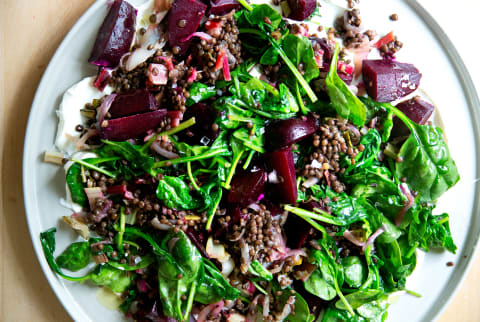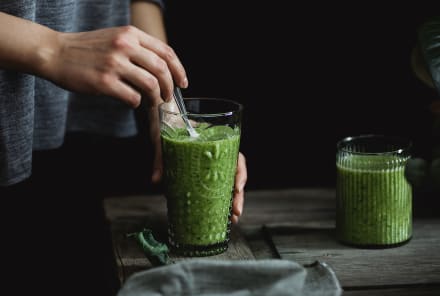Advertisement
13 Tips For Making The Most Of The Produce In Your CSA Box + A Recipe To Try


My first memory of a CSA box is the one my mom signed up for one summer—and the excess of dill and parsley it came with. For a few weeks, everything tasted like dill...even the recipes it wasn't in because the smell seemed to leach into everything else in the fridge, while my mom scrambled for ways to use the herb.
For those who are a little stumped: CSA stands for community-supported agriculture, and CSA boxes are often purchased from local groups, though brands like Misfits Market have gone bigger with the initiative. The system is designed to connect consumers directly with producers (in this case, the farmers) through a subscription, which is great if you love supporting local businesses and getting super fresh fruits, veggies, and herbs. The only drawback is that you won't know what's coming until it arrives (hence Dill-gate), so you've got to be ready to get creative.
Needless to say, back when I was growing up with our herby CSA, we could've used some help from Ali Stafford, a self-described CSA aficionado and the personality behind Alexandra's Kitchen. Luckily, I have it now: She was kind enough to share some of her ultimate CSA box tips with me, along with a recipe that's perfect for any miscellaneous veggies you may have on hand.
"I love my weekly CSA box foremost because I get delicious, fresh produce without having to make a trip to the farmers market and without having to pay farmers market prices," Stafford shared. While she notes that shopping at a farmers market does facilitate connection with farms and farmers, "there is something special about being very connected to a single farm, one you 'invest' in at the start of the season, then receive from all year long."
13 key tips for using your CSA box.
As I mentioned, the drawback (for some) of a CSA box is that you can never predict what produce you'll get—but for Stafford, that's one of the best parts. "I love the challenge," she says. "It's a weekly puzzle, a game to play all week until the eve of that next CSA's arrival, when creative measures must be taken to make room for the next delicious haul."
She also shares her "tenets" for successful CSA-ing, and they're too good not to pass along:
- Proper storage is half the battle.
- Separate roots from greens.
- Pool greens together.
- Use scissors to snip away rubber bands.
- Store basil out of the fridge.
- Make a simple meal plan.
- Know what to use first, what to use last.
- Know what to store in the fridge, what to store out of the fridge.
- Know how to revive tired greens: soak in cold water.
- Learn how to pickle or "quickle."
- Make herb sauces. Freeze them.
- Be organized.
- Give away what you can't use.
And you don't necessarily have to be super creative with your haul all the time: "It helps to have a few other tricks up your sleeve," says Stafford. And by tricks, she really means a few recipes that work for just about any produce assortment. Exhibit A: her go-to black lentils recipe.
Black Lentils With Salt-Roasted Beets, Swiss Chard & Labneh
Use this recipe as a template! The critical elements include creamy labneh + cooked lentils + leafy greens. The greens can be anything from Swiss chard to spinach to kale to mustard greens. I've been loving the addition of salt-roasted beets (or steam-roasted; see recipe) but know that you could add any roasted vegetables here such as zucchini, eggplant, and peppers in the summer, or sweet potatoes, Brussels sprouts, and butternut squash in the fall.
Serves 4 as a side dish
Ingredients
- 1 to 1½ lbs. beets, greens trimmed away (save them for another use, though!)
- ½ cup black lentils (or French green lentils, if you can't find black lentils)
- Kosher salt
- 2 tablespoons olive oil
- 1 onion, thinly sliced
- 1 bunch Swiss chard, 12 to 14 ounces, or 8 ounces spinach or kale
- ¼ cup white balsamic vinegar
- 1 cup labneh or lemony-yogurt sauce (1 cup Greek yogurt + 1 tablespoon fresh lemon juice + ½ teaspoon kosher salt)
- Flaky sea salt, such as Maldon, for finishing
Method
- To Salt-Roast the Beets: Preheat the oven to 425ºF. Pour kosher salt into a shallow roasting vessel to make a thin layer. Place beets on salt bed. Cover pan tightly with foil and place in oven for about 1 hour, depending on how many and how big your beets are. Note: To test for doneness, remove foil and slip a paring knife into one of the beets. If the knife meets little resistance, they are done. When beets are done, remove foil covering and let them cool. When cool enough to handle, rub off the skins—using paper towels here is helpful—and discard. Cut beets into 6ths or 8ths, and transfer to a bowl.
- To Steam-Roast the Beets: Heat the oven to 375°F. Nestle the beets into a small roasting vessel, such as an 8- or 9-inch round or square baking dish. Pour in ½ cup water. Cover with foil. Transfer to the oven for 1 hour. To test for doneness, remove foil and slip a paring knife into one of the beets. If the knife meets little resistance, they are done. When beets are done, remove foil covering and let them cool. When cool enough to handle, rub off the skins—using paper towels here is helpful—and discard. Cut beets into 6ths or 8ths, and transfer to a bowl.
- Meanwhile, place the lentils in a small pot and cover with water by at least an inch. Add a teaspoon of kosher salt. Bring to a simmer. Simmer till done. Times will vary. Black lentils will cook in about 22 to 25 minutes. If you are using French green lentils, they'll likely need a little more time. Taste before draining them.
- Meanwhile, in a large skillet, heat the oil over high heat. Add the onions and a pinch of salt. Stir. Cover the pan and immediately turn the heat to low. If you are using Swiss chard, remove the leaves from the stems. Coarsely chop the leaves and set aside. Finely chop the stems. Add the stems to the onions, give it a stir; then re-cover. I like to cook the onions and chard stems super slowly for the entire time the lentils are cooking. Open the lid to check on the onions and stems periodically, allowing any water trapped in the lid to drip back into the pan.
- Prepare the serving platter by smearing the labneh or the Greek yogurt sauce over top. Set aside.
- When the lentils are done, remove the lid from the onion pan and turn heat to medium. Add the vinegar and cook until it reduces by half, 1 to 2 minutes. Add the lentils and stir to combine. Add the beets and stir to combine. Taste. Season with salt if necessary.
- Add the greens and a pinch of salt, then turn off the heat. Leave the greens alone for 30 seconds; then use tongs or a large spoon to incorporate the greens into the lentils. You want to work quickly here—the goal is to get the greens to wilt and soften without losing their vibrant color. (Inevitably the greens will lose their bright color, but they will still taste delicious, so don't worry if this happens.) Taste. Adjust with sea salt as needed or a splash more vinegar if necessary.
- Immediately spoon the warm lentils, beets, and greens over the prepared platter.
Watch Next
Enjoy some of our favorite clips from classes
Enjoy some of our favorite clips from classes
What Is Meditation?
Mindfulness/Spirituality | Light Watkins
Box Breathing
Mindfulness/Spirituality | Gwen Dittmar
What Breathwork Can Address
Mindfulness/Spirituality | Gwen Dittmar
The 8 Limbs of Yoga - What is Asana?
Yoga | Caley Alyssa
Two Standing Postures to Open Up Tight Hips
Yoga | Caley Alyssa
How Plants Can Optimize Athletic Performance
Nutrition | Rich Roll
What to Eat Before a Workout
Nutrition | Rich Roll
How Ayurveda Helps Us Navigate Modern Life
Nutrition | Sahara Rose
Messages About Love & Relationships
Love & Relationships | Esther Perel
Love Languages
Love & Relationships | Esther Perel
What Is Meditation?
Box Breathing
What Breathwork Can Address
The 8 Limbs of Yoga - What is Asana?
Two Standing Postures to Open Up Tight Hips
How Plants Can Optimize Athletic Performance
What to Eat Before a Workout
How Ayurveda Helps Us Navigate Modern Life
Messages About Love & Relationships
Love Languages
Advertisement

New Study Confirms The 3 Habits That Age Your Brain Faster
Molly Knudsen, M.S., RDN

New Study Confirms The 3 Habits That Age Your Brain Faster
Molly Knudsen, M.S., RDN










